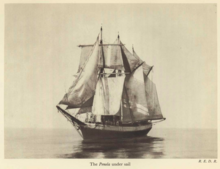

The Penola, originally laid down in Finisterre, Brittany,[1] was a fishing schooner named Alcyon,[2] and was later acquired by John Rymill for the British Graham Land Expedition to the Antarctic Peninsula in 1934.
Constructed in 1905 and launched in 1908 from the yard of E. Conne Kerity in France, this vessel boasted specifications well-suited for polar voyages.[3] She measured 106 feet (32 m) at the waterline, had a beam of 24 feet (7.3 m), and a draft of 11 feet 6 inches (3.51 m), amounting to a tonnage of around 138 tons. In terms of her rigging, the ship was designed as a three-masted topsail schooner.
At some point she was purchased and converted into a private yacht named Navaho. For enhanced maneuverability and power, she was outfitted with two 50-horsepower Junkers diesel engines. Upon her acquisition for the expedition, Rymill renamed the vessel after his family farm,[4] Penola, located in South Australia.
Given its robust construction, the Penola was inherently well-adapted for the challenges of the polar seas, and it had an impressive carrying capacity relative to her size.
The Penola (capable of a modest 4 knots) was the main transportation and most of the party travelled from England via the Falkland Islands and South Georgia to Antarctica in this vessel. The aircraft and dogs as well as a large part of the stores were, however, brought separately by a research ship, the RRS Discovery II.
In transit, an inspection of the Penola revealed that the timbers on which the engines were placed had warped while travelling through the tropics. Despite repairs, the engines began to move as the Penola sailed from the Falklands. The ship returned to collect concrete (so that a solid foundation could be made for engines when time allowed) and then set a course for Antarctica under sail. Penola reached Port Lockroy on 22 January 1935.[4]
The expeditionary crew, predominantly amateur, consisted of 16 men led by John Rymill, an Australian, who also acted as surveyor and second pilot. The shore party of nine included several Cambridge graduates, some of whom had acquired experience of polar conditions in Greenland as members of the British Arctic Air Route Expedition led by Gino Watkins. Although the expedition's ship was mainly powered by sail, few of the crew members had sailing experience.
The exploration of south Graham Land was a problem considered by Gino Watkins after his return from Greenland in 1931, but he was unable to raise the necessary funds, and was forced to abandon the project. He returned to Greenland, accompanied by Riley, Chapman, and myself, and was drowned there. Thus it fell to the lot of his followers to carry on the work in the south. On returning to England at the conclusion of the Greenland expedition, I immediately set about organizing one to Graham Land. Four of my old companions from the Watkins expeditions agreed to join me: W. E. Hampton, who came as second-in-command and chief pilot; Surgeon Lieutenant-Commander E.W. Bingham, Royal Navy, doctor and in charge of dogs; Alfred Stephenson, chief surveyor and meteorologist; and Q. Riley, whose jobs were many, as he was commissariat officer, meteorologist, and in charge of the expedition motor boat. The expedition numbered sixteen altogether and was divided into two parties - the shore party and the ship's party.
- ^ "DFB".
- ^ "Penola". Scottish Shipwrecks. January 15, 2023.
- ^ "Research yacht Penola under sail". State Library of South Australia.
- ^ a b "Freeze Frame » British Graham Land Expedition 1934-37".
- ^ "Geographical Journal - British Graham Land Expedition". www.jstor.org. JSTOR 1788186.